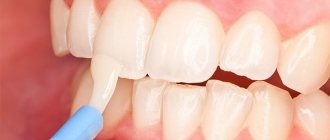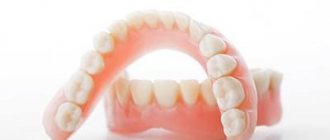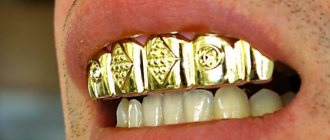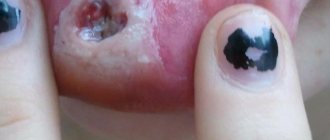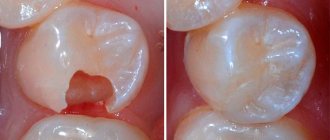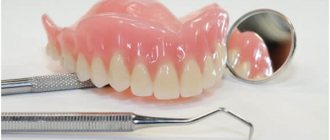Why do removable dentures made of plastic break?
There are many reasons that lead to the breakdown of structures, but you can organize repair of removable dentures at home. So, the reasons:
- Wrong work done by a dental technician. If the impression was taken incorrectly, the finished design will not be the correct size. To do this you need to sharpen it.
- Low-quality materials were used to make the prostheses; for example, when examining the finished product, you can see frozen air bubbles. Such a prosthesis is prone to deformation.
- Errors made during laboratory manufacturing can result in uneven distribution of chewing load or lack of a tight seal.
- If you carelessly care for the products and eat solid foods. In such a case, you should pay attention to the question of how to properly clean dentures at home.
- Using a solution that is not suitable for maintenance.
- Changes in the jaw apparatus (occur over time), leading to a loose fit of the structure.
- Long-term operation when the service life of the product ends.
Do you need to repair it yourself?
Many people, faced with the problem of a broken medical device, believe that fixing the defect at home is quite capable of replacing a trip to a specialist.
This opinion is erroneous, since in some cases, independent restoration of the device without subsequent professional repairs can have negative consequences:
- In dental clinics, special hypoallergenic compounds are used for repairs, which fully ensure the safety and reliability of their use.
If you try to prepare the glue for work on your own, it is likely that the proportions are not observed or the sequence of actions is incorrect, which results in the risk of final damage to the prosthesis. - Repair work (repairing or replacing clasps, clasps, restoring the base, crowns) requires high precision, professional equipment and is carried out only by a qualified specialist.
- It is almost impossible to achieve a perfectly smooth surface treatment of the seam in the place where the house is glued, and the presence of the slightest pores and roughness is a habitat and breeding ground for many pathogenic microorganisms.
Attention! It should be noted that after manipulation of the dental apparatus outside the walls of the clinic, the device is not subject to warranty service.
What to do if your denture is cracked or broken - step-by-step instructions
The first question that arises is how can you glue a denture at home if it breaks? Be sure to contact the clinic. Only there will they help determine the severity of the defect. It may be possible to seal the prosthesis or have to make a new one. Sometimes fixing a defect will cost more than making a new design. In addition, independent repair (for example, if you have to adjust the fastener without experience) can lead to complete breakdown and further unsuitability of the product, even if an experienced specialist undertakes the repair.
When repairs are needed
Reasons why structural repairs are required:
- change in color of artificial teeth. You should not try to whiten dentures yourself;
- discomfort when using structures for their intended purpose, which has not occurred before;
- chips and cracks - one of the most common breakdowns, occurs due to uneven chewing load when chewing solid food;
- loss of one or more crowns;
- poor fixation to the oral mucosa due to natural subsidence of the bone tissue of the alveolar processes.
Read Which doctor deals with dental prosthetics with different types of prosthetics - description of the activity
Should you glue a broken denture with superglue?
How to glue a denture in case of mechanical damage at home? For gluing, we can assume that regular superglue will do. In fact, this is a wrong and erroneous decision. It is not intended for this purpose; it is toxic and has an unpleasant taste. Under the influence of superglue, the prosthesis will deteriorate and will not be repairable.
In such cases, it is necessary to use special products designed specifically for gluing. But under no circumstances should you use unknown household materials. Since this can cause not only final breakdown of the structure, but also your own poisoning.
When is repair needed?
It is not always possible to restore a broken prosthesis. If it breaks or bursts in half, the structure cannot be repaired. If the damage is one of the following, restoration is possible.
Chips and breaks
A broken piece, even if it is not visually noticeable when you smile, is a reason to urgently contact a specialist. The resulting sharp edge of the crown can damage mucous and soft tissues, which will cause additional discomfort. The method for solving the problem is gluing the elements that have broken off. To make the surface look smooth and even, a special sealant is applied over the glue.
It is also necessary to repair a denture if a small piece of the ceramic top layer breaks off from a metal-ceramic crown. As a rule, restoration in such cases is carried out quite quickly, directly in the doctor’s office, using composite materials.
Cracks
The most common reason why denture owners seek repairs. Even if the crack is small and does not affect the functionality of the product, there is no point in postponing restoration. It can grow to more serious defects, up to a final break, and then it will not be possible to save the product.
The doctor assesses the repairability of the structure. If the crack is small, it is enough to polish the surface by removing the top layer to eliminate it. In case of volumetric cracks, it is recommended to replace the structure: even after use, it will be unreliable and may break.
Damage to fastenings
Any fasteners that hold removable dentures on the supporting teeth can break:
Here is a detailed article about caring for removable dentures, rules, recommendations, and here in detail about the types of removable dentures.
- clasps;
- locks (attachments);
- hooks;
- clasps.
Relining is required when a gap forms between the denture base and the gum
Relocation
Relocation is the procedure for changing the position of a structure. The need for it arises if a gap forms between the edge of the prosthesis and the gum. As a result, the tissues are injured, food gets into the gap and an unpleasant odor appears, and diction changes.
Repairing a removable denture
It is unlikely that it will be possible to repair a prosthesis at home efficiently and for a long time. For help, you will have to contact a dental laboratory, where a suitability examination will be carried out, an assessment will be carried out and repairs will be suggested. This will take several days.
Features of restoration
Restoration is carried out as follows. Special glue is poured into the crack. Once it dries, plaster is applied on top. After the time required for the plaster to dry, the structure is separated and sanded without touching the oral mucosa. After this we need acrylic. It is applied to artificial crowns and polished after hardening. The finished denture is polished, without noticeable defects, and looks like real teeth. Only a dental technician can make and repair the structure. For this he uses special materials. However, not all dentures can be repaired. It is impossible to restore structures made entirely of plastic or stamped products.
What is used for gluing
At home, you can temporarily fix the structure with special glue, which is sold in a specialized store. For example, a special adhesive composition is suitable for this purpose. However, such a design will not last long. It is recommended to seek professional help as soon as possible.
So, gluing instructions - step 1
We will need medical plaster in order to make a base on which the prosthetic structure will rest (photo), it can also be made from wax (all means are good at home):
Step 2 - gluing option without reinforcement
The second step in our repair, after the impression has been created and has assumed a strong (frozen) state, we can begin gluing the prosthesis (photo):
Please note that we glue the plate prosthesis with a liquid acrylic mass, having previously prepared the necessary solution. Of course, for this you need to have a pre-prepared acrylic-m repair kit in your home pharmacy; you can buy it at a pharmacy or order it from a specialized online store:
Colorless plastic for repairing plastic dentures
Analogues of liquid acrylic
Analog "Acryl-M"
Step 3 - gluing with titanium mesh reinforcement of the base of the prosthesis
If we want to make the prosthesis even stronger, and also so that it will serve us for a longer period, we just need to add a metal mesh to the base to strengthen the structure:
This mesh is placed at the base of the prosthesis structure, pre-adjusted in size, and then filled with a liquid acrylic solution. The thickness of the layer should be such that it covers the reinforcing mesh:
Read Dental prosthetics on implants - pros and cons, indications and contraindications
After all repair work has been carried out on the prosthesis, let the acrylic harden - the recommended period is indicated in the instructions. Although hardening can also be determined by the hardness of the structure.
Next, the prosthesis needs to be washed well and, if necessary (or if possible), polished. After which the prosthesis can be used further for its intended purpose!
Urgent repair of dentures, addresses in Moscow
The duration of work is determined by the complexity of the breakdown. The time range varies from repair in front of the patient (if you need to glue a broken piece of ceramic coating) to several days (when you need to replace a broken unit).
Metal parts also take quite a long time to repair, so such repairs cannot be urgent. The approximate duration of restoration and elimination of defects is indicated in the table:
| Up to 2 hours | Up to 5 hours | Up to 24 hours |
| Repairing cracks | Welding the crown to the base | Repair of nylon structures |
| Chip restoration | Restoring locks by cooking | |
| Relocation |
Urgent repairs are performed only by those clinics that have their own dental laboratory. Another option is to contact dental technicians directly. Some addresses in Moscow:
- Ortho-Lux, orthopedic workshop. Lodochnaya, 6
- Zircondent is a milling center that restores ceramics. Usievicha, 8.
- Denta-Rus is a Russian-Swedish dental center. Nikulinskaya, 27.
- Denta-Lab, dental laboratory. Polymer, 8.
- Ustadent, dental clinic. Dubninskaya, 26.
- All our own, dental clinic. Rusakovskaya, 22.
Review of zirconium crowns and their advantages
Urgent repairs are possible in clinics with their own dental laboratory
An important point to remember: the cost of repair also depends on whether the prosthesis is under warranty. If the warranty period has not yet expired and the breakdown did not occur due to the patient’s violation of the operating rules, the clinic is obliged to restore the product free of charge.
That is why, when choosing a center where prosthetics will be performed, it is important to clarify whether a guarantee is issued for the work performed.
Restoration of the prosthesis in the clinic
Only a specialist can fully repair the prosthesis. After inspection, the extent of its damage is determined. Then a suitable method of denture restoration is selected. Laboratory and clinical methods are used in the recovery process. Before repairs, your dentures should be thoroughly cleaned. If the surfaces are poorly cleaned, it will be impossible to glue. A special adhesive composition is used for gluing. A specialist must carefully match the surfaces to be glued. If it is not possible to fix the prosthesis or there is a lot of damage, then a new structure is made instead. If a fracture of the denture is accompanied by the loss of the crown, then it can be glued and the crack can be soldered. The result should be a monolithic structure without visible defects and irregularities.
How to repair a prosthesis at home?
In domestic conditions, polymer and composite materials for special purposes are used to repair a prosthesis.
There are special dental adhesives designed for home repair of broken orthopedic structures.
- ROCS A polymer composition that quickly hardens in air. It firmly glues the parts of the product together. If you apply the glue carefully, the gluing area will not even require sanding.
- "Coracryl." Composite two-component composition that dries in air. It must be prepared immediately before gluing the broken product.
- "Protacryl", "Redont". Glue, which is prepared from two components - powder and a special liquid. The components are mixed to obtain a homogeneous polymer mass, which is then applied to the prosthesis. The glue hardens quickly in air.
Price issue
Depending on the material from which the structure is made and the severity of the damage, the cost of repairs may vary. To eliminate a crack, fracture, or restore ceramic-metal products, you will have to pay up to 1,800 rubles. The cost of a broken crown will be approximately 2,500 rubles. Polishing the prosthesis, professional cleaning, after disinfection will cost 1000 rubles.
Thus, the cost depends on the amount of work performed, the severity of the breakdown, and the material with which the specialist has to work. If you want to save money on professional repairs, then you should prepare for the fact that a fitted prosthesis repaired by yourself will soon fall apart.
Video - repairing a nylon prosthesis
You can learn how to make dentures at home by watching the video. The nylon prosthesis itself, if its shelf life has not passed, is difficult to break quite easily, but if you seriously approach such an issue as repairing nylon prostheses, then it is still better to contact a specialist. Known failures of a nylon prosthesis may include the loss of an artificial tooth.
According to the recommendations of a specialist (dentist - orthopedist) on the YouTube channel, it is possible to make a denture at home, but the best quality work will remain that which was carried out in a dental laboratory. It makes sense to repair a prosthesis in the following cases:
- design no more than 2 years from the date of its manufacture;
- it is possible to weld a new cover in the form of a clasp;
- if several teeth are missing in the mouth.
If the denture is more than 3 years old, there is no point in repairing it, and also if more than 3 teeth are missing in the mouth. Repairing dentures is less expensive than making a new one. If you lose 4-6 teeth, there is no point in repairing a nylon denture, since making a new one will cost the same as repairing an old denture.
But under no circumstances should you use unknown household adhesive materials. Since this can cause not only final breakdown of the structure, but also your own poisoning.
Repairing a plastic prosthesis
How to make a denture at home if it is made of plastic? The tips below will help you fix the situation with a minor breakdown. First you need to assess the extent of the damage. The work will require special materials (for example, acrylic), which can be purchased in dental stores.
- It is recommended to wash broken fragments with special care in a soapy solution and then dry thoroughly.
- Install the halves and connect them clearly along the fault line, apply wax.
- Dilute the plaster, which should be placed on the product from all sides.
- After the plaster has hardened, the prosthesis is carefully separated from it.
- Grind the chip line at an angle of 40%. You should not touch the surface that will be adjacent to the oral mucosa.
- According to the instructions, prepare the material (plastic) for pouring.
- Apply the prepared mixture to the plaster model and leave until hardened.
- The resulting hardened structure is ground and polished.
- Finally, the finished prosthesis must be washed in soapy water.
Read repair of removable and conditionally removable dentures: repair of acrylic dentures, repair of clasp dentures
Making a prosthesis at home is a labor-intensive task that requires special equipment, time, and skill. This manipulation is resorted to when it is not possible to contact a dentist in the near future.
Removable denture repair
Repairing a denture with your own hands is only possible if the clasp needs to be corrected when bending it. This should be done after consultation with an orthopedist or dental technician, since careless bending of the clasp can lead to its rapid breaking off. It is especially important to pay close attention to the base of the clasp.
Small bending of the hooks occurs constantly and requires careful correction
If a crack occurs in the base of a removable denture, it is recommended to immediately contact an orthopedic dentist. A crack will very soon lead to the prosthesis breaking, but at the crack stage, repairing it will be much easier.
If there are cracks or breaks, adhesive should not be used to repair dentures. Firstly, adhesives recommended for everyday use are not intended for prolonged contact with the oral mucosa. As a result, various chemical or allergic damage to the palate or other areas of the mucous membrane may occur. Secondly, adhesives usually do not provide the required bond strength.
To repair removable dentures, the same acrylic plastic is used as for its manufacture. The affinity of the prosthesis material and the connecting plastic guarantees a reliable restoration.
Material for the manufacture and repair of removable dentures
When a prosthesis breaks, a linear defect usually occurs, the volume of which is negligible. If the fracture line is covered with glue or base plastic, then the amount of material added will not be enough for a quality repair. Therefore, when repairing, the dental technician uses a milling cutter to remove part of the base of the removable denture, which is subsequently replaced with a new portion of plastic. The parts of the prosthesis are connected on a plaster model, cast either from a cast of the patient’s jaw or from the inner surface of the prosthesis itself.
Repairing removable dentures is a process that requires professional skills, a large set of dental equipment and special materials. Therefore, it is much more reliable, faster and cheaper to entrust the repair to a qualified dental technician.
Placing an additional tooth or replacing a broken clasp is also done on a plaster model cast from an impression taken from the jaw along with the applied prosthesis. After plastering the models in an articulator, a device that fixes the correct relationship of the jaws, the technician uses wax to adjust the new tooth to the required place. The wax is then replaced with plastic in the same way as when making a prosthesis.
What is important to know to prevent prosthesis breakage
In order for a plastic prosthesis to serve for a long time, this should be taken care of at the planning stage. Correctly placed artificial teeth and clasps distribute the load towards the strongest areas of the prosthesis that are resistant to fracture. In addition, a special metal reinforcing structure can be placed in the base of the prosthesis, arc-shaped for the lower prosthesis and mesh for the upper. Such an addition will slightly complicate manufacturing and slightly increase the cost, but it will greatly extend the service life of the prosthesis.
The cast metal mesh serves as reliable protection for the prosthesis from breaking.
The prosthesis should be stored in places inaccessible to children and pets. You should avoid keeping them in bright sunshine, as well as near heating appliances.
It is important to wash the denture with special solutions containing surfactants, antiseptics and proteolytic enzymes, which facilitate easier removal of food debris and saliva. Do not use aggressive agents - acids, alkalis, or abrasives (pumice, tooth powder, etc.). To clean dentures, you need to have a separate toothbrush, which should be changed as it wears out.
If the prosthesis breaks often, perhaps you should think about making a new one using more modern technology. Removable dentures made of nylon are practically devoid of the ability to break. Their elastic base is easily deformed under external load, but when the pressure is removed, it immediately restores its original shape without damage.
Nylon prosthesis easily tolerates significant deformations
Rules for caring for fixed dentures
How to clean fixed structures so that they last as long as possible:
- Carry out oral hygiene regularly (at least 2 times a day) - clean dentures in the morning and evening using powder or paste;
- It is important to pay attention to hard-to-reach areas. If, after prosthetics, bacteria get under the structure, an inflammatory process may develop. Rinsing with various compositions will help to disinfect. They can be purchased in stores or pharmacy chains, or you can make them yourself (herbal decoctions: calendula, chamomile, etc.);
- It is recommended to use dental floss and irrigator. Such devices will help remove plaque and food debris from hard-to-reach areas.
It is important to periodically visit a specialist who can detect minor chips, cracks and restore the structure before it is seriously deformed.
Features of pharmacy adhesive for dentures
Advantages and features:
- hypoallergenic;
- compatibility with prosthetic materials;
- the glue does not lose its properties under constant exposure to saliva and liquids;
- gives a long-lasting effect;
- Sold only in specialty stores, so it may be difficult to find.
Of the many existing drugs, Protacryl-M or Coracryl are most often used. They are almost identical in composition and general characteristics.
This glue is sold in kits containing all the necessary tools. This is especially convenient for DIY repairs.
Contents of the kit and composition of the drug:
- powder – polymer (self-hardening plastic based on a fluorine-containing copolymer of the acrylic group and an antiaging agent);
- liquid (methyl methacrylate, which contains a cross-linking agent);
- dichloroethane glue (can be used instead of sticky wax);
- release varnish (used to isolate the plaster model and prevent it from fusing with acrylic).
How to use it correctly?
For successful results, you must strictly follow the instructions for use. The mixture is diluted in a glass or porcelain container in a powder to liquid ratio of 2:1.2 (Coracryl) and 2:1 (Protacryl).
The mass must be thoroughly mixed; there should be no lumps or grains in it. Cover the dish with glass for a short time and leave to swell. The finished glue has a smooth and shiny structure, the consistency of sour cream. In order to glue the parts faster, you can place the model under an incandescent lamp.
How to care for removable dentures
How to clean and properly care for dentures at home? The right question for those who have started using removable structures. Because the service life of dentures depends on the care they take. Crowns often darken due to plaque. The reason for its appearance is insufficient care. The surface of the structures is slightly rough, so dyes from food and drinks easily penetrate into it. How to clean dentures at home, and what solutions are suitable for this?
The easiest way is to clean with a special tooth powder or tablets. Dentures are 10 times softer than tooth enamel. Regular toothpaste contains abrasives that scratch the surface of artificial crowns, which promotes the accumulation of bacteria that cause an unpleasant odor. To do this, you should use specialized products available in tablets. It is recommended to add one tablet to a glass of water. The prosthesis should be immersed in the solution for no more than 3 minutes. Before use, the product should be removed and washed under running water.
It is recommended to remove the prosthesis twice a day to remove any remaining adhesive. Among the available cleaning products, you can use regular baking soda applied to a brush. It can be dissolved in the amount of 1 teaspoon per glass of water to prepare a solution in which the prosthesis is stored after removal.
It is possible to prevent the occurrence of plaque and stone by periodically boiling the denture for several minutes. Diluted vinegar or citric acid removes dark deposits well.
Dentures will remain a reliable design if they are properly cared for, according to the above recommendations, and protected from various mechanical damage.
Causes of failure
The most common factors affecting the integrity of structures include:
- presence of defective prosthesis at the manufacturing stage;
- incorrect installation;
- errors in care;
- heavy load on the structure (for example, chewing too hard food);
- jaw injury;
- falling of the structure onto a hard surface;
- low quality of materials used to manufacture the product;
- destruction and loosening of teeth that serve as support.
According to statistics, modern structures break down in 10% of cases during the first year of operation. Following your dentist’s recommendations for caring for your prosthesis will significantly extend its service life.
Types of breakage of removable dentures
The service life of a conventional plastic (acrylic) prosthesis is 3-5 years, clasp structures made of thermoplastics and metal - about 8, and flexible nylon prostheses - 5-7 years.
Up to 60% of removable orthopedic devices made of any material break before the stated period, and in 10% of cases this happens in the first year of operation.
The most common breakdowns:
- A fracture or crack in the base of the structure.
- Broken clasp (hook lock).
- Chipping of an artificial tooth.
- Impaired fixation of the prosthesis.
- Removal of the abutment tooth, to which the structure was attached, and the need to replace it with an artificial one.
Types of breakage of removable dentures
How repairs are carried out in dental clinics
Repairs are carried out in dental laboratories. The specialist determines the nature of the breakdown, the degree of complexity, possible repair options, taking into account design features and other aspects.
The repair method differs significantly depending on the type of structure:
Clasp
Clasp prosthesis
Repairs are made in accordance with the nature of the damage. In case of some breakdowns, for example, if the frame is broken, it cannot be restored. The clasp is repaired by replacing damaged metal components. Cracks are eliminated by treatment with special resins and further polishing. At the same time, the design does not change its aesthetic and functional properties.
The cost of repairing clasp devices ranges from 300-400 to 2000 rubles, depending on the nature of the damage.
Nylon
Nylon prosthesis
Such prostheses are characterized by elasticity and flexibility. Most often they are damaged due to cracks and chips. Repair consists of applying special adhesive materials that reliably fasten damaged parts of the structure.
If the integrity of the nylon body is completely damaged and the structure has split into 2 elements, the prosthesis cannot be repaired.
The cost of restoration is from 1,500 rubles.
Fixed
Fixed prosthesis
This design is quite complex, and therefore in case of many damages it cannot be restored. The problem can only be eliminated by replacing it with a new prosthesis. The most common types of fixed prostheses are dental crowns and bridges. Such dentures can be saved only from two types of damage - chips or cracks.
Chips are repaired by performing restoration. The color of the material is selected to match the color of the crown, and then applied to the chip site. After application, the filling material is dried and polished to achieve a natural shape.
Also, chips can be restored by gluing the broken part. For these purposes, special dental adhesive solutions with increased strength are used.
Bridges are usually removed during restoration to make the procedure easier and eliminate the need for the patient to spend a long time in the dental office. During the restoration period, temporary crowns can be installed.
The cost of restoring crowns and bridges, on average, ranges from 1.2 thousand rubles. In case of significant damage, the cost of repairing a bridge can be 5-7 thousand rubles.
Acrylic
Acrylic prosthesis
The main feature of this design is the absence of moving components. Therefore, breakdowns most often come down to chips and breaks caused by falls, impacts of the prosthesis, or other unfavorable factors.
Elimination of chips is carried out by applying thermoplastic, which replaces the broken structural element. After this, the denture is polished to give it its original shape.
If one of the crowns is damaged, it is replaced. On average, this procedure lasts no longer than 1 hour and can be performed directly in front of the patient.
The cost of restoration of acrylic dentures varies from 400 to 2000 rubles.
Metal-ceramic
Metal-ceramic prosthesis
Such dentures are elements of fixed structures, but can also be used on removable dentures. Metal-ceramic dentures are repaired only when chips or cracks appear. Other, more serious damage cannot be eliminated, which requires replacement of the crowns.

